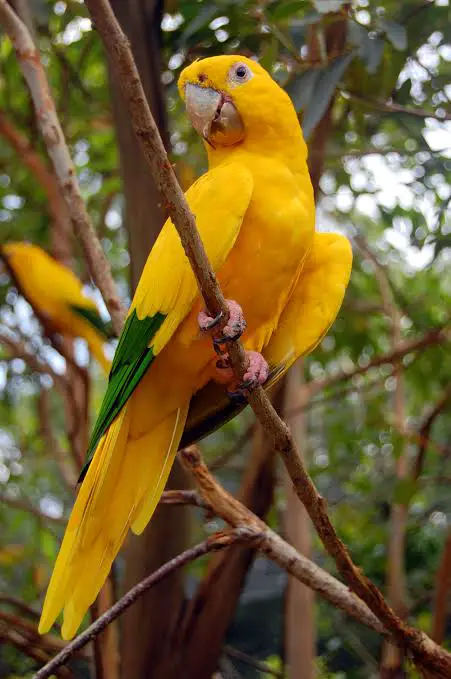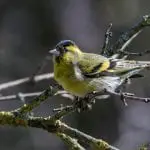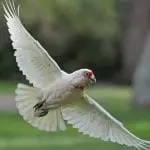Scientific Facts
| Common Name | Golden Conure |
| Scientific Name | Guaruba Guarouba, formerly Aratinga Guarouba |
| Origin | Northeastern Brazil and within Tapajos, lower Xingu and Tocantins in the south to northern Brazil, state of Para |
| Habitat | at around 174,000 km2 above sea level; During the non-breeding season, they occupy tall trees while during the breeding season, they are seen to occupy open areas such as fields for agriculture |
| Diet | different kinds of vegetables, plants, seeds, flower buds and crop plants such as mangoes, acai, muruci, and maize |
| Size and Weight | 34 cm (13 in) long with about half a pound (270 grams) |
| Life Span | 20 years in the wild and up to 35 years in captivity |
Physical Description
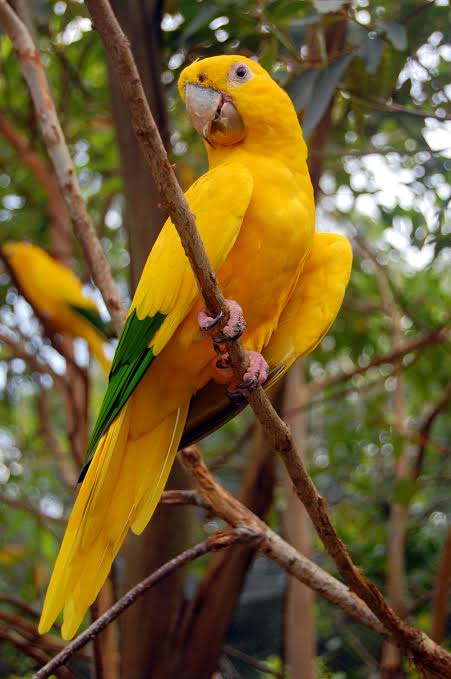
The golden conure or known as the Queen of Bavaria conure is known for its stunning brilliant yellow color with green hints, especially on the wings that provide a contrasting effect on its overall physical appearance. It is characterized by its large head and its gray horn-colored beak with a bald ring around their eye area that compliments their brown irises. They are often mistaken as macaws, but golden conures have pink legs and shorter tail. The juveniles are identified to have green specks on their feathers, and their wings and cheeks are slimmer with a duller yellow coloration in their bodies.
Where it is Seen?
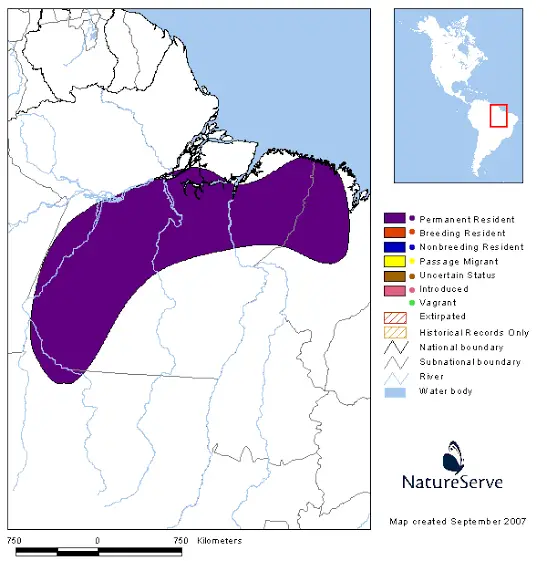
It is a native conure species to northeastern Brazil and within Tapajos, lower Xingu and Tocantins in the south to northern Brazil, state of Para.
Habitat
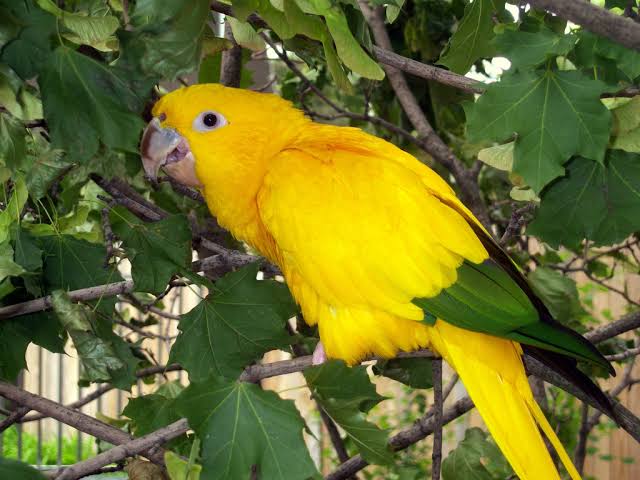
They thrive at around 174,000 km2 above sea level. During the non-breeding season, they occupy tall trees while during the breeding season, they are seen to occupy open areas such as fields for agriculture. They are tagged as nomadic since they often move from tall trees to lowland humid forests
Behavior and Temperament
Golden conure is an active conure species that loves to roam around to socialize with other golden conures; usually, they stay in the flock. They are talkative conures that can be vocal and produce loud screams. They love to mimic what they hear from their environment. They are already naturally intelligent but in captivity, for it be enhanced, they need a lot of exposure to metal stimuli that will keep them active because if they are bored, there are higher chances that they’ll become aggressive and show destructive behaviors towards themselves, this is the common behavioral characteristics of a conure, but golden conures are more sensitive when it comes to neglect, boredom, and stress. Taming them is easy; that is why training them with a lot of tricks is not complicated. They are receptive to music that they’ll sing or dance to the beat.
Breeding and Reproduction
The golden conure reaches sexual maturity when they reach the age of three; the mating season runs from November to February. Like other parrot species, they build their nest in a high tree, which they guard aggressively from larger birds like toucans that feed on other bird’s eggs and juveniles. The females lay about 3 to 4 clutches of eggs with an average length of about 1.46 by 1.18 in (37.1-by-29.9-millimeter).
Both males and females can take turns incubating the eggs for 30 days. The juveniles look totally different from only white coloration all over their bodies, but it slowly changes within the week. Their wing will start to develop by the time they reach their 4th week. Both males and females take turns in taking good care and feeding their young, but as soon as their wings show off, they’ll still abandon them.
Diet
Golden conures have a wide variety of diet in the wild that includes different kinds of vegetables, plants, seeds, flower buds and crop plants such as mangoes, acai, muruci, and maize.
Size and Weight
The golden conure is characterized as a medium-sized conure with a total length of 34 cm (13 in) long with about half a pound (270 grams). The golden conures are considered as one of the biggest clowns in aviculture.
Life Span
There is no recorded lifespan in the wild but experts had estimates that they can live for about 20 years in the wild and up to 35 years in captivity, but with its current population standing, experts propose that it nowadays, it is quite difficult to achieve this lifespan in the wild due to different kinds of problems such as destruction of their habitat and illegal hunting.
Common Diseases/Illnesses
Golden conures are a hardy conure species wherein they are not that susceptible to common diseases or illnesses of parrot species if they are staying in a place that has an ideal environment. But the prevailing diseases or illnesses cannot be totally removed from the equation, but it can be prevented from worsening. These are some of the diseases or illnesses common to golden conures and how they are treated.
1) Psittacosis in Birds (Parrot fever)
Parrot fever is also known as chlamydophila, psittacosis, or ornithosis. It is an infectious disease that infests parrot species. It is spread out through the bird’s droppings or from their dust. These are the symptoms of Psittacosis disease: lack of appetite, depression, difficulty breathing, mucus discharge from eyes, and nose and Watery, green droppings.
If you see just one symptom, take it immediately to your veterinarian because it can cause sudden death of your bird if it is not treated immediately. Antibiotic treatment to kill the bacteria is necessary. You need to be cautious in handling them if you see some symptoms because psittacosis is contagious to humans that will bring very flu-like symptoms.
2) Polyomavirus
This infectious disease is common to both mammals and aviary. The impact of polyomavirus on the golden conure is fatal, especially to juveniles, because it directly impacts their immunity. If the bird has enough immunity to fight the infection, there is a higher chance that your conure would be able to survive. Research shows that the older the conure is, the more it develops immunity. It is not contagious to humans, but it can the disease can be transferable to other birds through their droppings and if humans touch an infected bird and then hold another bird.
Conure species are more prone to polyomavirus among the parrot species. The symptoms of polyomavirus are loss of appetite, vomiting, diarrhea, dehydration, weight loss, and swollen abdomen. There is no cure for this disease; once the bird gets infected, the bird will be weak slowly and soon die. There is a vaccination to avoid this disease, but it is advisable to do it before the bird develops its wings. Make sure that the environment where you would take your pet is always hygienic.
3) Pacheco’s disease
This is caused by a herpes virus that can be spread easily through nasal discharge and feces. It is not contagious to humans, but birds are more susceptible to this disease if they are stressed or depressed, especially over the loss of their cage mate. The symptoms of this disease are sinusitis. Lethargy, tremors, anorexia, and green droppings. These symptoms may often lead to sudden death. There is an antiviral drug that is used to combat this disease ,but its side effects can cause kidney damage; that is why quarantine is a preventative measure.
4) Giardia
This is an intestinal infection that is caused by parasites. When the bird is infected with this disease, their feces have cysts that van be contagious to other birds. Your bird is susceptible to this disease if the food that you are giving to them, as well as the water sources are dirty. It is also contagious to humans if the water supply that they drink is the same as the bird. Giardia symptoms to golden conures are dry itching skin, diarrhea, bulky stools, weight loss, and depression.
5) Malnutrition
The most common diseases or illnesses are usually due to malnutrition. If your pet is enriched with nutrients, it is less likely that they will be infested with different illnesses. Malnutrition leads to lower immunity. Making sure that you are providing your conure with the right nutrients is complicated; that is why you may need to check the bird supplements guide so as to be accurate in giving them a balanced diet. Aside from the nutrients from their food, they should also be exposed in full-spectrum sunlight. A sign that your pet has a nutritional deficiency is when there is a change in their physical appearances, such as feather stress bars, and shows weakness.
6) Proventricular Dilatation Disease (PDD)
This disease directly affects the nerves of the bird that supply to different organs of their body, especially in the gastrointestinal tract. This is also known as the Macaw Wasting Syndrome and Parrot Wasting Syndrome because this disease is commonly seen in Macaws, Amazon parrots, cockatoos, African grey parrots, and conure species.
The symptoms of Proventricular Dilatation Disease are vomiting, weight loss, swollen muscular pouch near the throat, and changes in the consistency of the texture of their droppings. Nonsteroidal anti-inflammatory drugs are known to regulate this disease and that it is necessary to give them a special diet provided by the veterinarian. There is no cure for this disease, but the give drugs are to reduce the pain the bird is experiencing to avoid irritations.
7) Psittacine Beak and Feather Disease (PBFD)
This is a serious disease that affects all the members of the parrot species; that is why it is referred to as the bird AIDS because AIDS seen on humans almost has the same symptoms. Birds that are under two years old are more susceptible to disease, but it can affect all birds at any age. The symptoms of Psittacine Beak and Feather Disease include abnormal feather development, feather loss, abnormalities of the beak, and lesions on their skin. The veterinarian may conduct skin and/or feather biopsy and some supportive care to alleviate their pain.
8) Ulcerative dermatitis
This is a skin disease that can easily irritate the parrot. A sign that they are irritable is when they peck their skin that eventually leads to wounds and breakage. It brings itchiness and stinging sensations. When you see that your parrot has an open wound, make sure to do first aid so that it won’t be infected. There are ointments that can ease irritations.
9) Overweight parrot
When the parrot looks fat, it doesn’t mean that they are healthy. Being fat is next to being overweight or obese, which is an unhealthy physical physique for a bird because it can be a cause of different diseases or illnesses. Overweight is due to an improper way of feeding them, may it be the schedule of feeding or the variety of foods that are given to them. The more healthy options, the less likely that they’ll be overweight. If your parrot’s body is too heavy, they’ll have difficulty moving; it restricts them from moving properly. You may need to consult your veterinarian for the list of foods that can be given to them, just avoid sugary and fatty-based diets.
10) Avian Gastric Yeast (AGY) infection (megabacteriosis)
This disease targets the ability of your parrot to digest food because of the bacterial and yeast infection leading to weight loss. It is quite difficult to identify if your parrot has an Avian Gastric Yeast (AGY) infection (megabacteriosis), especially during the first phases because your parrot will not lose weight at once. You may need to observe them carefully. As soon as you see undigested food from their feces or vomit, this is already a sign that they have a problem digesting it. Your veterinary would advise you to give them antibiotics for about a week so as to kill the bacteria and replace the good cells that had been infested.
11) Feather Picking and Self-mutilation
Feather Picking and self-mutilation are usually due to behavioral problems caused by boredom, stress, and sexual frustration. As soon as your bird learns this behavior, it can no longer be unlearned; that is why when you notice unusual behavior from your bird, take it immediately to your veterinarian. This behavior is usually triggered if your bird is lonely and bored; that is why it is always important to make them feel that they are not alone by playing with them, or you can have them in pairs.
Preventing Illnesses
If you observe any signs that your golden conure is having a health problem, the best workaround is to take it immediately to your veterinarian for early detection and treatment. As a pet owner, it is important to know simple ways on how to detect or spot symptoms if your bird is sick. These are some of the ways to detect or spot illness:
- Check the bird’s head; if their head is asymmetry, it is a good sign that your bird is not suffering from any heat-related issues. If you noticed that one part of their head is larger than the other or if there are lumps, it could mean that there is swelling in their head.
- Check the appearance of their eyes. If you noticed that their eyes look sunken, dull, color change, if it is half-closed, if there is redness or if there are lots of feathers, most likely, your pet is suffering from a certain illness.
- Examine their nasal area as well as their beak. Mucous discharge in their nasal area and discolorations and flakiness of their beak would mean respiratory illness. If your bird is wheezing, there is a possibility that they are having difficulty breathing, so you must take them immediately to the veterinarian because it is fatal. Also, take note that a healthy conure would breathe with their mouths closed. You should also check if your bird’s beak is growing abnormally. If it grows too long, you may just trim it down, or there is a possibility that there is a more serious health problem.
- Look for any changes in the feathers if it has abnormal colorations, dullness, matting, wetness, or breakages. Also, check for any bald spots because there is a possibility that your bird has started to pull out its feathers. Make sure that their feet and legs are free of discolorations, crusty buildup, flakiness, and swelling.
- You should be able to master their normal behavior, so by the time that they change in attitude, you could easily detect what they are going through.
Captive Breeding
Golden conures are an excellent pet to be taken in captivity because they are not only good looking, but they are naturally affectionate and intelligent. However, they are expensive because they are rare in the wild. They are also hard to find because there are heavily regulated. Current owners would say that even though it is expensive, it is still worth it finds. Before captivating a golden conure, it is important to conduct research about how to take care of these conures.
Availability-Where to Get One?
It is illegal to sell and buy golden conures; you may need to have a special permit that will allow you to obtain it. Even though they have a bright color, it is quite difficult to spot them in the wild because they tend to hide a lot. Aside from purchasing golden conures from different pet shops, you may want to adopt from the rescued from shelters.
How to Care Parrot as a Pet?
1) Housing
Golden conures are active; they climb, fly, play, and sleep. You may place it in a cage with dimensions of 3ft x 3ft x 3ft if it lives alone. If they will stay in pairs, at least place them in a cage with dimensions of 12ft x 6ft x 6ft. They have a strong chewing ability; that’s why you may need to have a toy in their cage that won’t easily break, such as wooden toys. There should be a separate bowl for water and food. During the breeding season, make sure that they have a privacy play where they can stay, you may need to provide a nesting box that has at least 9”x16”x12” dimensions to be placed inside the cage. You can place their cage indoors or outdoors, just make sure that the temperature is always above 60°F to avoid health problems.
2) Food
You can choose from a variety of foods that will surely supply the daily needs of nutrients of your conure. Aside from pelleted seeds, you may feed them with cucumber, cucumbers, apples, grapes, cauliflower, broccoli, capsicum, sweet corn, yellow and red peppers, cooked pumpkin, spinach, and beans. Feeding them with an equal amount of fresh foods and pelleted seeds will surely fill in the nutrients they need to avoid malnutrition.
3) Accessories
The accessories that you can place in their tank are toys and hiding places. Make sure to put a lot of wooden toys to keep them active and for them to avoid boredom. They are also curious about things; that is why giving them playful activities will keep them busy. These birds need room to climb, play, and explore; they enjoy foraging, and putting treats or food in a crumpled piece of plain paper is a wonderful game for them. It is advisable to place hiding places 1 hiding place for breeding purposes and other hiding boxes for playing purposes. There are some instances where they need to hide to release the tension that they are feeling.
4) Exercise
In order to keep them physically fit, they need exercise. Owning a golden conure requires time and effort, which will require you to have at least three to four hours a day to supervise your pet out of the cage for training or playing. Make sure that their cage is equipped with things that they can navigate, such as ropes, swings, and ladder.
5) Care
Cleanliness should always be maintained in their cage to avoid different health problems. You can clean all their water bowls, a food bowl, and wooden toys weekly. It is also advisable to give them baths and showers regularly to keep them comfortable and clean. Always check their beaks and nails if it needs trimming.
Conservation Status
Golden conures have been declared as an endangered species way back 1975 because back then. There were only about 3,000 of their population left in the wild but due to the different efforts from different organizations, their population as of the moment is about 13,400 that is why the IUCN marked it in the vulnerable level, meaning it is no longer extinct, but it is still considered threatened due to the destruction of their habitat, illegal hunting from juveniles from the nest to the mature ones for captive breeding or as food. One of the most problems why their population is impacted due to overselling to different breeders because they are in-demand because of their appearance.
Fun Facts About Golden Conure
- They love to spend more time staying on their nest even though it is not the breeding season.
- They are called the golden conure, but their feathers are not prominent in yellow color. The color that stands out when they fly is in the shade of green.
- A golden conure has the ability to hide any signs of diseases or illnesses so that they won’t be an easy target to their predators; that is why if they show symptoms of their illness, it could mean that they must be very sick.
FAQ Section
Is golden conure a good companion?
For them to be a good companion, they need to be exposed to other conures and to humans. They are suitable to stay in captivity because they love to be petted, making them a perfect pet for children, just make sure that they are handled properly.
Are golden conures good pets?
Golden conures are naturally good-looking, intelligent, and affectionate; that is why they can be a good pet, especially if you want to train them. They need an owner who is willing to give them time to play with them out of the cage.
Should I cover the cage of my golden conure cage at night?
You may cover their cage during their sleep hours since it is ideal that they have an undisturbed sleep for at least 8 hours, but during the day, always remove it so your golden conure can interact with its surroundings.
Are golden conures considered as parrots?
Golden conures are characterized as a parrot that is small-medium in length. The conures, in general, belong to the New World parrot subfamily Arinae group.
Why do golden conures bob their heads?
Head bobbing is normal. For males, they do this as a mating dance while bobbing their head up and down while climbing at the highest point of their cage.
Are golden conures aggressive?
Golden conures are considered as wild, aggressive animals if they are taken out directly from the wild during the adult years, there are high chances that they can no longer be tamed that is why it is advisable to get from reputable sources.
What do golden conure noises mean?
Golden conure produces several loud calls, especially if you leave the room, and there is no one available whom they can play with. Other reasons are being excited.
Can I keep my golden conure under the sun?
Daylight is necessary for their digestive functioning, and for them to be healthy, but direct exposure is not advisable because they can be prone to hyperthermia.
Does the golden conure need a lot of attention?
They need a lot of attention, especially in captivity, that is why before choosing to take good care of them, make sure that you have enough time for them. If they get bored, there are high chances that they will develop bad habits.
How to distinguish if my golden conure is a female or male?
They can only be distinguished through DNA sampling since there are no differences when you would compare their bodily structure.

